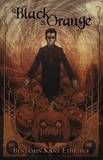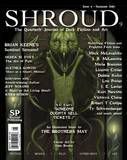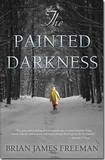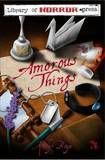"Becoming One with the Ghosts" / Kristine Kathryn Rusch
 Asimov's Science Fiction / Oct-Nov 2010
Asimov's Science Fiction / Oct-Nov 2010
Reviewed by: Daniel R. Robichaud
Though Asimov's Science Fiction seems an unlikely place to find fiction with a dark bent, the October/November issue contains quite a few eerie pieces, including Kristine Kathryn Rusch's novella "Becoming One with the Ghosts."
The story set-up is this: When damages force the interstellar spacecraft Ivoire to dock with Sector Base V, its captain expects a brief delay before rejoining the remainder of The Fleet. However, Sector Base V is no longer populated by Fleet personnel. Evidence suggests it has been long abandoned. This is a strange development as the station was active a month before. Now the station's inhabits include visible clusters of floating particles and a small group of explorers in unfamiliar environment suits. Captain Cooper and the Ivoire's 500 crew members are caught in a mystery. Soon they discover an unknown accident has caused the Ivoire's travel time to far exceed the month they believed. Investigation soon becomes two-fold: How much time has been lost, and what has happened in the meantime? The answers are not reassuring.
Though this story is not a bloody tale of alien horror, a Lovecraftian excursion into other dimensional madness, nor a slasher-in-space exercise, "Becoming One with the Ghosts" is no stranger to dread. Here, the dark dealings are of a philosophical bent.
The prose is engaging, and the questions raised are intriguing. Motifs of abandonment, decay, and death populate this narrative. Though no spectral figures surface, the tale reads like an understated ghost story.
Accounting for lost time has provided the genesis for quite a few excellent terror tales, such as L. Ron Hubbard's Fear. Here we find a fresh take on the same theme. Rusch's effort is an engaging tale of a most unconventional haunting.
Purchase Asimov’s Science Fiction (October/November 2010), which includes “Becoming One with the Ghosts” by Kristine Kathryn Rusch.
An excerpt of the story is also available at the ASF website here.
Black & Orange / Benjamin Kane Ethridge
 Bad Moon Books / October 2010
Bad Moon Books / October 2010
Reviewed by: Anthony J. Rapino
Reading a writer’s first novel is always an exciting endeavor. It’s a chance to discover a new talent. It’s a chance to track the author from book to book, watching and noting with pleasure the growth in each new offering. So was my mindset entering the world of Black & Orange, Benjamin Kane Ethridge’s first novel.
Martin and Teresa are nomads tasked with protecting the Heart of the Harvest, a human who holds the key to opening a gateway between worlds in his or her chest. On the other side of this gateway lies the Old Domain. Every Halloween Chaplain Cloth and his “children” – a horde of pumpkin-headed demons – quest after the Heart, which, once devoured, will open the gateway a little wider.
This year is a game-changer, for if even one more heart is lost, the gateway will be wide enough for the Old Domain to spill through into our world, bringing chaos and death.
Helping Chaplain Cloth, who is trapped in the Old Domain until Halloween, are members of his Church who hope for the merging of the two worlds. Teresa and Martin are powerful, but the cards are stacked against them. Teresa is suffering with lung cancer, there are four hearts to protect this year, and Paul Quintana – a new, powerful Bishop – is helping to track them down.
It may be the horror fan in me, but any novel that takes place on and around Halloween gets brownie points. It’s not fair, and it may not be the most professional of confessions, but it is the truth. The truth is also that Ethridge didn’t need the help.
Black & Orange is a fast-paced, yet thoughtful, novel that explores the balance between opposing forces. The colors black and orange may as well be good and evil, or yin and yang. These complimentary opposites play against each other throughout the novel — and within the characters.
The Messenger – the unseen player who tells the nomads what to do – can be God in the way the nomads blindly follow his (or her) will. And Chaplain Cloth, the Devil, prying open a gateway to expel his domain into ours.
And yet, it’s never as simplistic as this. Ethridge, with great care, creates layered, believable characters that aren’t simply good or bad. Each and every one of them has their own needs, wants, and problems. Bishop Quintana is obsessed with a Priestess, whom he would disavow himself for. Martin constantly tries to get Teresa to quit smoking, while she stubbornly resists. The story is never only about whether or not the gateway will be opened, and for this reason alone, Black & Orange is a dynamic and unforgettable novel.
Whether for Halloween, Christmas, or the Fourth of July, in the world of Black & Orange, it’s always autumn.
Purchase Black & Orange by Benjamin Kane Ethridge.
"Footsteps" / Marie Brennan
 from Shroud Magazine / Issue 9, Summer 2010
from Shroud Magazine / Issue 9, Summer 2010
Reviewed by: Daniel R. Robichaud
Shroud Magazine's ninth issue opens with Marie (Midnight Never Come) Brennan's variation on a classic fairy tale.
In "Footsteps" readers find a prince searching for a wife, a grand ball attended by masked guests, and a mysterious party crasher who rushes away at the stroke of midnight, leaving muddy footprints. Of course, we are squarely in "Cinderella" territory. The tale is brief, yet readers will find several different masquerades, a kingdom-wide search for an unidentified lady (complete with specially crafted footwear), a heartfelt proposal, and the big reveal that this is not a happily-ever-after story but a chilling tale of an unwelcome surprise guest.
The plot is straightforward and perhaps predictable to anyone familiar with the "Grim Fairy Tales" from Haunt of Fear comics. The Rule of Three tells savvy readers how many balls there will be. This tale's appearance in a magazine dedicated to the macabre tells us not to expect a straight "Cinderella" retelling. However, the story remains enjoyable due to its descriptions, its playful skewering of the familiar, and several enjoyable turns of phrase. Just take a look at the first line:
"Among the noble flowers that have gathered for the ball, the hopeful young ladies in lavender and spring green and pink, she stands out like a rose, red-black as venous blood."
How could readers resist venturing on?
Since 1993, Ellen Datlow and Terri Windling have edited several anthologies that offer dark re-imaginings of fairy stories (like 1993’s Snow White, Blood Red). Brennan's tale hearkens back to those anthologies in all the right ways; it uses the familiar to weave a well written dark fantasy.
"Footsteps" is a tasty treat, a literary morsel to be savored for its rich sentences, its images, and the way it builds to a chilling conclusion.
Purchase Shroud Magazine, Issue #9 (Summer 2010), which includes “Footsteps” by Marie Brennan.
The Painted Darkness / Brian James Freeman
 Cemetery Dance / December 2010
Cemetery Dance / December 2010
Reviewed by: Blu Gilliand
Brian James Freeman has gotten a lot of attention for the way he's gone about marketing his new book from Cemetery Dance, The Painted Darkness. In case you're one of the few who hasn't heard — he gave it away. Every word, available for free as a download. There was no gimmick. There was no agreement required that those downloading the file would turn around and purchase the physical book when it comes out in December. Hey, he even gave it to this reviewer twice — not long after I downloaded the electronic version, he was kind enough to send me an advanced copy of the printed product.
So, while we've heard a lot about the way Freeman is publicizing his work, we’ve yet to hear a lot about the work itself. I have no doubt that's going to change as we march closer to the publication date, and I'm happy to be among the first voices moving beyond the cry of "It's free!" and into the realm of "It's great!"
Because it is, you know. It's an ambitious piece of storytelling that delves not only into the mysterious act of creation itself – something that many in Freeman's audience will be able to relate to – to something we can all relate to: the crippling power of childhood fears. The fact that it does all this in quiet, understated tones reminiscent of the likes of Charles L. Grant makes it all the more amazing, moving and powerful.
Henry is a painter, living in an old rural farmhouse with his wife and young son. His attic is his workspace, and lately he's been spending a lot of time up there – even more than usual – painting canvases that he promptly turns to face the wall. He can't remember what he's painted on those, and for the time being it doesn't seem important. On this particular day, he's poised in front of another blank canvas, seeking that thin entryway into the state of semi-dreaming that he enters when he works. It's not coming easy, though, as there's more than art on his mind — his wife, upset at the amount of time he's been zoning out and working lately, took off with his son last night, and he hasn't heard from them since they left.
Eventually, though, he eases into work, only to be brought out of his reverie a few hours later as the boiler in the cellar begins making ominous sounds. As he breaks away from painting to take care of the boiler, Henry finds that the threads of a childhood memory are beginning to come back to him — a memory that ties right into the core of his artwork. Freeman presents that memory to us in a series of flashback chapters intercut with the chapters following present-day Henry, allowing us to discover the incident even as Henry is recovering its memory for the first time in his adult life.
In The Painted Darkness, Freeman is doing far more than telling a scary story (although he is telling a scary story, and doing it quite well). He's looking at the questions that all artists are frequently asked. Questions about where ideas come from, and whether something imaginary becomes real once the artist brings it to life. Writers in particular talk often about how their "real" and "imaginary" worlds blend together — how often have you heard writers say that their characters speak to them, or that they feel less like they're making something up and more like they're transcribing events that are really taking place? If characters in books seem real to readers, imagine how they must seem to the one that created them.
For Henry, the reality of his creations is even more, well, real than most. And as the events of this book unfold, both in the present-day sections and the flashback, we begin to understand how dangerous that reality is, and how important his work has become.
Freeman balances both narratives expertly, dovetailing them together at the end so that we are presented with one cohesive, impactful story. Jill Bauman contributes a series of black-and-white illustrations that perfectly convey the mood of the tale.
The Painted Darkness is a quick read, but it’s one that sinks in and stays with you for a while. Artists will have a special appreciation for Freeman’s views on the nature of creation, but anyone who has an appreciation for the work that artists do – not to mention the appreciation of a good old-fashioned spook story – will enjoy this book.
Purchase The Painted Darkness by Brian James Freeman.
Amorous Things / Kody Boye
 Library of Horror Press / August 2010
Library of Horror Press / August 2010
Reviewed by: Daniel R. Robichaud
Kody Boye's collection Amorous Things (originally published by Lame Goat Press in 2009, new edition from The Library of Horror) contains 17 stories that range from dark fantasy to gory horror, from moody meditations to terror tales in the spirit of Stephen King and Tales from the Crypt. As with most collections, this is a mixed bag — readers will encounter some truly moving prose and some overwrought sentences, some stories that succeed and some that don't. As this is Boye's first collection, it is no surprise to find such range. The surprise comes not from its low points, but from the highs of its successes.
Until reading this book, I was unfamiliar with Boye's work. These stories reveal a writer with promise, though that promise is not yet fully realized. The fiction is often written with a lyrical language, playful turns of phrase, and some honest emotions. What the stories lack in subtlety, they often make up for with passion.
Unfortunately, several pieces lacked the necessary life details to hit full on verisimilitude. The stories they tell are fantastic in ways they should not be, in ways that broke my ability to suspend disbelief. Whether it's a matter of a homeowner giving no concern to a water bill hike when he wakes to find the outside spigot has been running all night, to the technical detail that completely exposed lungs should collapse instead of continuing to work for weeks/months while the victim watches, there are dozens of places that broke my belief in the fictional situations' reality. Fantasy and horror require a baseline of believability or else a good clue to the ways the story's world is different from the one readers know.
That said, when Boye's fiction is really working, it achieves a dreamlike lucidity and emotional authenticity. The collection's standout story ("Dreams") follows a teacher and his star high school student who share dreams about swans, dragons, and fantastic landscapes. The two discover these nocturnal visions are more than metaphors, when they learn of a swan nested in pollution threatened land. Their struggle to save this majestic creature from its toxic environs makes for a moving tale, a spiritual horror piece. The questions it considers are not only topical (in these days of Gulf oil spills and other environmental issues) but prescient. In many ways, the story reads as purposeful provocation – as stated before, the prose can be unsubtle – but it seldom stoops into either the propagandistic or pedagogical. Answers are not made explicit; questions are.
Boye's driving themes are plain in these tales. The title of the collection suggests affection, and this makes its way into the contents. Many of the stories center on relationships — the two most popular are either widowed men with their remembered spouses, or fathers and their sons. A few surprises leap out however, including a pair of stories that feature well-developed homosexual relationships. One of these, the moving "War is in the Hearts of Men," tackles its Don't Ask, Don't Tell material with a fresh approach and authentic pain.
The stories dealing with the horrific and the supernatural from odd angles are often the strongest pieces in this work. Such fiction as "Elijah" (about the dysfunctional relationship between a beautiful young man and his elderly lover, which builds to a macabre conclusion) and "An Amorous Thing" (exploring the sensations a corpse experiences after its brutal murder) stand head and shoulders above some of the more "traditional" horror pieces, such as "Beautiful Woman" (wherein a masked woman-creature uses the question "Am I beautiful?" to determine what boys she will mutilate with a hook). Boye's strengths lie in evoking the unfamiliar otherworldly. Reliance upon the familiar ghosts or torturing lunatics often results in less interesting reads.
Boye is still finding his way in his fiction. While Amorous Things has its share of shortcomings, its contents also suggest a promising future for this storyteller. Many of these tales are still early pieces, but they are not amateur works.
Purchase Amorous Things by Kody Boye.
The Disappearance / Bentley Little
 Signet / September 2010
Signet / September 2010
Reviewed by: Daniel R. Robichaud
Bentley Little's latest excursion into terror fiction delivers creepy thrills and unexpected twists as a group of adventurous college students find themselves victims of strange circumstances.
Before beginning another year at UCLA, Gary and his friends head into Nevada's Black Rock Desert for the Burning Man project. They expect a fun excursion at the week-long festival. Instead, mystery cuts their pleasure short. Waking from a surprise drugging, the friends find one of their number has disappeared. At first, they suspect Gary's girlfriend Joan has just wandered off. When this proves not to be the case, suspicions take a darker turn: Perhaps she has been taken against her will.
The local sheriff's department is no help. Officially, missing persons cannot be reported for 48 hours. In the end, Gary's friends convince him to return to Los Angeles, in the hope that Joan might have somehow made it back there.
Joan is not waiting for them. In fact, her dorm roommate has also vanished. Involving the LAPD reveals even odder turns: there are no school records, no DMV files, no social security information, no documentation for either of the disappeared girls.
Gary cannot stop searching for answers behind Joan's disappearance. His near-obsessive struggles to understand how someone can suddenly cease to exist brings troubles aplenty. Soon the friends face dangers beyond their expectation or experience.
Bentley Little's fiction is often at its best when it quirks normal situations by introducing elements that are both oddly funny yet chilling. Novels like The Store, The Ignored, University, and Dispatch (as well as stories such as "The Washingtonians" and "The Wheel") use surreal and satiric terrors to create engaging fiction often unlike anything else in the mass market. The Disappearance's opening half channels the bizarre and the unexpected. The deepening mystery starts strong and grows increasingly intriguing, hinting at either real world or supernatural conspiracies. The book seduces its reader through disparate clues.
However, The Disappearance's narrative is not a single-minded tale of horrific uncertainty. When the novel hits its second half, the mystery is quickly resolved. At this point, it leaves behind the ambiguous horror of its beginning and marches into thriller territory, where it remains through the close. The protagonists become increasingly more active, as they explore their discovery and its macabre implications.
The result is a book with distinctly different moods. This reviewer found the opening half incredibly effective. Little possesses extraordinary skill at imbuing the mundane with menace. Strangely dressed figures skulking across a college campus, a scroll begging protection from someone or something called "The Outsiders", a phone book containing entries identified by role instead of name, and authority figures hiding possibly sinister motivations provide the basis for some surreal but gripping chills.
While the latter half provides violent, thoughtful, page-turning action, once the novel shifts its focus from horror story to straight-forward thriller, readers may find themselves losing some of interest. This is not due to the actual writing; Little's prose remains engaging throughout, as immersive as Richard Laymon's best works. This reviewer’s lessened interest was due more to plotting that relies on overly familiar thriller tropes and expectations. That said, well-developed characters can hold readers' attentions despite almost any plotting decisions, and enough interesting personalities occupy this work to keep even jaded thriller readers going.
The characters Little employs are especially interesting. The college kid-heavy cast calls to mind many, many horror flicks and suggests this book might be a sadistic tale of slashers and sex. Instead of playing to this expectation, Little's cast serves a different purpose. They are old enough to know a thing or two about the world, but they are not so old as to be fully trusting with or entrusted by The System. Experience changes them, clarifying the novel's curiously schizophrenic structure.
In the beginning, the characters are beset by an apparently hostile world; threats arise from any direction (particularly from adult sources). Over the course of the novel, Gary and his friends mature into active parts in the world, ultimately shaping events instead of being continually pushed, pulled, or shaped by them. This is clearly coming of age material.
The Disappearance marks a welcome turn in Little's impressive catalog, diverging from the grim-but-gleeful horror stories of his previous works. It is always nice to see writers venturing into new territory and exploring their driving themes from new directions. Here, darkness is identified but not wallowed in; hope and humor peek through in equal measure. The result is an intriguing novel that stands alongside other coming of age thrillers, such as Richard Laymon's The Traveling Vampire Show, Joe R. Lansdale's The Bottoms, Jeff Strand's Pressure, and Dean Koontz's The Voice of the Night. As a regular Bentley Little reader, this is one reviewer who wonders just what he’ll do next.
Purchase The Disappearance by Bentley Little.
Thrillers: 100 Must Reads / Edited by David Morrell and Hank Wagner
 Oceanview Publishing / July 2010
Oceanview Publishing / July 2010
Reviewed by: Martel Sardina
Thrillers: 100 Must Reads is a collection of essays written by today’s top thriller writers on the one hundred “best” books of the genre. For readers who are unfamiliar with the thriller genre, this collection provides a quick and easy way to find books that are worth reading. For current fans of the genre, this collection provides the opportunity to find out which books have inspired their favorite authors along the way. And for those writers aspiring to be the next Lee Child or David Morrell, this collection provides critical information about the craft behind each of the selected works. The deconstruction of plot and character, and analysis of such, is a virtual blueprint for writers seeking to pen stories of their own.
The “100 Must Reads” list was compiled by seeking the opinions of noted reviewers as well as members of the International Thriller Writers organization. While Morrell and Wagner readily admit that limiting the number of books selected for analysis was arbitrary, that does not mean that they did not go to great lengths to ensure that the books that were selected had a measurable impact on the genre. Those that were selected made the list by being groundbreaking in some way — subject matter, character type, writing style/technique, etc.
The list itself covers a wide range of fiction, starting in 1500 B.C. with Lee Child’s essay on the ancient Greek myth, “Theseus and the Minotaur,” and ending with Steve Berry’s take on The DaVinci Code which was published in 2003. There are also some unexpected choices on the list, books that this reviewer never thought of as thrillers per se, such as James Fenimore Cooper’s The Last of the Mohicans or Jack Ketchum’s Off Season, a novel that would probably be shelved in the horror section of many bookstores. However, the fact that Morrell and Wagner would broaden their horizons to include books that some might think to be outside their scope is actually proof that the editors carefully considered the merits of each of the titles that were initially suggested.
What made this collection of essays most interesting was the opportunity to find out which books today’s top thriller writers were passionate about and drawing comparisons between the books they chose to write about and that author’s own work. It’s no surprise to learn that J.A. Konrath is a fan of John D. MacDonald’s The Green Ripper. Or that Konrath believes that the character of Travis McGee is the “template for the modern day thriller hero.” However, having reading Konrath’s Jack Daniels mystery series, this reviewer can see the practical application of that template when Konrath created his series character, Lt. Jacqueline Daniels.
The essays are presented in a similar format. Essays average three pages long, beginning with some biographical information on the author of the selected work, moving into the critical analysis and wrapping up with a short bio of the essay’s author. The consistency in terms of format gave the collection a textbook feel. In addition, several authors that contributed essays to this collection (F.Paul Wilson, Lee Child, and Jeffrey Deaver, to name a few) have works that are also the subject matter of essays themselves.
Readers should be warned that many of the essays do contain spoilers. Writers who are looking to deconstruct stories to figure out what makes a “good” thriller work may not mind these revelations. However, casual readers and fans may want to steer clear of essays for books on their “to be read” list in order to avoid disappointment in the event some critical plot or character elements are revealed in the analysis of said works.
Morrell and Wagner have compiled a collection that is useful to both readers and those aspiring to write in the thriller genre. The only downside to reading this collection is the likelihood that your personal “to be read” pile will no doubt get larger as a result. But that’s a problem that can be overcome in time. And one that most readers won’t really mind.
Purchase Thrillers: 100 Must Reads, edited by David Morrell and Hank Wagner




